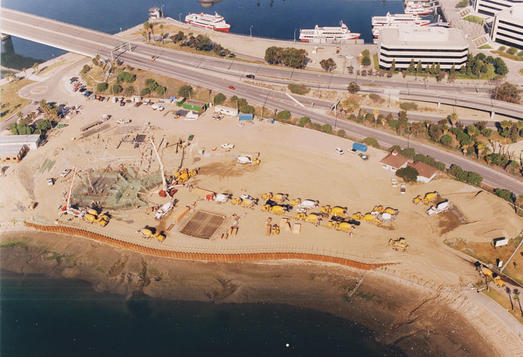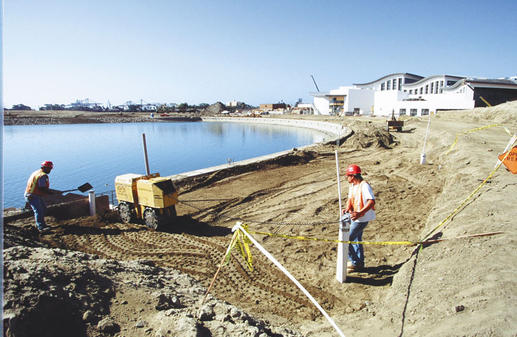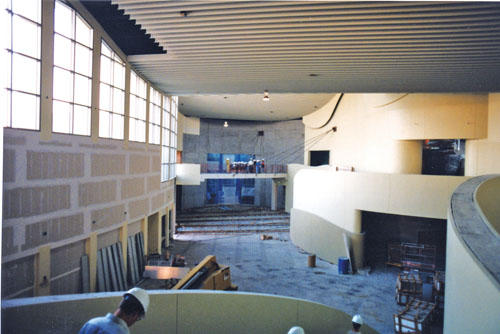When the decision was made to develop Downtown Long Beach’s waterfront with an aquarium as its anchor, the city was in somewhat of a state of limbo. The recent departure of the U.S. Navy and the loss of a potential development by Disney had left the city and its downtown waterfront, which was then nothing more than a tidal mudflat, with somewhat of an identity crisis. In 1994, recently elected Mayor Beverly O’Neill made moves to solve that dilemma by bringing together a group of Long Beach stakeholders and leaders for a project that would ultimately bring millions of visitors to the city and create a significant cultural institution for the community.
“We were in a stage where we were losing our major source of revenue when the Navy left, and we were planning how we were going to revitalize ourselves,” O’Neill recalled. “Many people in the city had different ideas with what we should do down there. Some people said, ‘Don’t touch it. It’s the duty of Long Beach to have a native-looking waterfront.’ So there were differing views. But it has been a project that has been so accepted by the city. Now, they are so proud of it.”

As then-City Manager Jim Hankla recalled, the idea for an aquarium on the waterfront was plucked from the conceptual plans for DisneySea, a failed attempt to develop Long Beach’s waterfront as a marine theme park. “We decided that we would use their architects and decide how we could cherry-pick their ideas and see what we could come up with,” he said.
“My view was that we had this wonderful shoreline. . . . And I believed very strongly that we ought to build some icons of excellence,” Hankla said. “I thought the Aquarium from the get-go was a great idea to do that.”
In a meeting at The Madison restaurant on Pine Avenue, now known as The Federal Bar, Hankla and O’Neill scribbled names on a napkin – names that would ultimately make up the founding nonprofit board tasked with raising the money to build an aquarium.
Doug Otto, one of the founding Aquarium of the Pacific boardmembers, was on the city’s planning commission at the time. “I knew that, for Long Beach to take the next step forward to be a successful community, what it needed to do was to develop some gravitas in some area – and that was a logical area,” he said of downtown’s waterfront. “I used to tell people that, if you looked out on where Rainbow Harbor and Queensway Bay are, that I never saw anything legal going on out there while I was growing up in Long Beach.”
Jim Gray, then the chairman and CEO of Harbor Bank, became the founding chairman for the Aquarium board in part as a favor to O’Neill. “When Beverly O’Neill was talking about running for mayor, I talked to her and . . . I said, ‘If you run, I know you’ll get elected. I’ll do any one project you want,’” he recalled. After she was elected, O’Neill called Gray to tell him she was creating a nonprofit board to raise money for an aquarium, and that she wanted him as its chair.

“I said, ‘Bev, before you go any further, I had two goldfish once and they both died,’” Gray said. “And she said, ‘Well, that has nothing to do with it. All you have to do is raise 100-and-some million dollars and hire a director and build the thing and fill it up with fish.’”
Unlike other aquariums in the country that were built largely with major donations, the Aquarium of the Pacific had to be built by raising the money through the sale of municipal bonds. Russ Hill, chairman and CEO of downtown-based investment firm Halbert Hargrove, kidded that O’Neill tricked him into joining the board. He and Gray were largely tasked with overseeing the sale of the bonds, which ultimately sold out within about two hours.
“As an economic development, it seemed like a great idea,” Hill said. “There was a statistic that came out which was that the average third grader in Long Beach, if you go up 15 or 20 blocks, had never seen the ocean. . . . And so I thought, if you want to have an informed citizenry, it’s a little hard to have people vote for conservation when they have never seen any of this stuff. So those were the motivations, and it seemed like a great idea.”
Steve Young, a partner with downtown-based law firm Keesal Young & Logan, joined the board in 1997, a year before the Aquarium opened. He pointed out that the Aquarium has helped transform the Long Beach waterfront from the “rougher, tougher” Navy town it once was.
“It was a great accomplishment to open the Aquarium,” Young said. “It’s a lot easier to open an Aquarium when somebody wants to give you a couple hundred million dollars to do it. And we did it the hard way. And the risky way. It was a good gamble, and a lot of people rolled up their sleeves and opened their pocketbooks and were good citizens and supported the endeavor.”

Young added, “There were people who in 1997 or 1998 said . . . ‘Oh my gosh, they will never pay the debt and this will be a disaster for Long Beach.’ They wrung their hands, but they were wrong. And we have proven that we are something that makes Long Beach special.”
The board selected Warren Iliff, a zoo executive from Phoenix, as the founding president of the Aquarium of the Pacific. “When we hired Warren Iliff, he was the perfect hire,” Gray said.
“We were blessed with a great CEO to begin with, Warren Iliff, who I love and will always remember,” Young said. Iliff retired in 2002 and passed away in 2006. “He had so many great attributes and he played such an important part in our early success.”
When the Aquarium of the Pacific opened, it took steps to ensure that local school children would be able to visit. “We made sure no kid would be rejected because they were at a disadvantaged school or whatever,” Gray said. “We set up scholarships to make sure everybody was going to get in. . . . Watching those kids who had never even looked at an aquarium in their lives and seeing the looks on their faces, it was great.”
About 1.8 million visitors came through the Aquarium of the Pacific in 1998, the year it opened, according to Hill. But the facility couldn’t accommodate that many people at the time, and the experience wasn’t pleasant for attendees as a result. To address the issue, the Aquarium has since expanded with new exhibits and areas such as the Lorikeet Forest, Shark Lagoon, the Molina Animal Care Center and more. It now comfortably accommodates about 1.7 million visitors per year.
Dr. Jerry Schubel was selected as Iliff’s successor in 2002. “We did a search for a replacement and we found Jerry Schubel, who comes from academia and is a Ph.D.,” Young said. “He had done a lifetime’s worth of writing and research about the ocean and about the environment and was very knowledgeable.”

Under Schubel’s leadership, the Aquarium developed several academic programs for youth and adults, a guest lecture series, and numerous cultural festivals and collaborations. “Right from the beginning, both Warren and Jerry thought that the Aquarium should be a place for all people of all races and nationalities and all different backgrounds and all different cultures. We have tried to make them all feel welcome,” Young said.
The Aquarium’s educational focus is now being expanded with a new addition to the Aquarium, Pacific Visions. The new wing, which is currently under construction, will combine technology, the arts, science and marine life to educate the public about humanity’s impact on the world and its oceans.
“Jerry Schubel had this dream. He convinced the board that we needed to move with the progression of technology and science into additional opportunities for the public’s participation,” Hankla said of Pacific Visions. “I think it provides an opportunity for the Southern California population, the population throughout the state: an immersion in technology that they can find nowhere else.”
Asked about the expansion, O’Neill reflected, “With the visionary leaders that we have had there, it has become a place that is not just where you go and look at the fish and the things of the sea. But it has been educational. . . . And then, when the new development comes, it will be the showplace of aquariums.”
“My hopes are that we continue to try to be innovators and we try to continue to emphasize education and the environment and the ocean,” Young said. “As I look back at raising children, and now raising grandchildren, I am so grateful to the Aquarium for everything that they have done for my family in making us better citizens and stewards of the environment. . . . It’s such a special place and I urge people to take advantage of it.”
